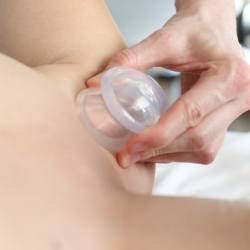
Looking At The Benefits Of Dynamic Cupping
May 7, 2019 3:43 pmCupping has been around for centuries, and different cupping methods have been developed throughout history. Dry cupping, or static cupping, is the more traditional method, where glass cups affect acupuncture points for pain relief. Flash cupping, a stimulating technique, uses plastic silicone cups placed in succession with reduced pressure for a fast second. Dynamic cupping, a technique created by the Seminars for Health team, combines massage cupping movements, joint movements, and the negative pressure created by the proper use of silicone cups. The cup is moved by controlled and monitored suction away from the muscle creating fascial space and allowing for muscle relaxation.
There are considerable benefits to therapists and patients who practice dynamic cupping. This technique increases muscle relaxation-the tissue separation created by the suction makes space, allowing an influx of nutritious lubrification needed for muscle flexibility and relaxation. Dynamic cupping separates myofascial layers-when injured or stressed, the body becomes tight and less mobile. The suction vacuum lifts and separates the tissue layers, creating an ideal environment for healing. Dynamic cupping reduces joint pain and stiffness- by activating synovial fluid release into the joints through joint mobilization and decompression, reducing joint pain and stiffness.
Dynamic cupping effectively reduces pain, increases function, and flexibility, and improves patients’ quality of life. Dynamic cupping increases circulation, reduces inflammation, and reduces muscle tension. A study in 2017 supports the use of dynamic cupping in patients with non-specific chronic neck pain. The patients underwent cupping twice a week, and the average pain reduction in these patients was 36%. Not only does dynamic cupping hold significant benefits for patients, but it also allows therapists to achieve a deeper and more effective massage with less effort. This makes massage physically easier on therapists, so dynamic cupping is a highly effective tool for any massage therapist.
However, dynamic cupping can increase the risk of bruising, blistering, discomfort, and blood clots in patients without professional training. Cupping is also dangerous for those with specific populations and health conditions, such as children, the elderly with fragile blood vessels, or diabetics. Cupping caught the attention of many around the globe when cupping marks were noticed on Michael Phelps alongside other professional athletes. With increased cupping popularity, those wishing to integrate any level of cupping into their practice must receive professional massage training. Continued education allows massage therapists to incorporate new techniques while protecting their patients from unsafe practices.
Seminars for Health has created an original dynamic cupping course designed by massage therapists with over 20 years of experience. A course designed with the benefits of dynamic cupping and the safety of your clients in mind.
Sign up for our newsletter to read more about our courses.
Sources
Saha FJ., Schumann S., Cramer H., Claudia Hohmann K-EC., Rolke R., Langhorst J., et al. The Effects of Cupping Massage in Patients with Chronic Neck Pain. A Randomised Controlled Trial. Complementary Medicine Research. 2017; 24(1), 26-32. https://www.karger.com/Article/Abstract/454872#
Mohammed Al-Bedah, A., Shaban Aboushanab, T., Saleh Alqaed, M., Akhtar Qureshi, N., Suhaibani, I., Ibrahim, G., & Khalil, M. Classification of Cupping Therapy: A Tool for Modernization and Standardization. Journal of Complementary and Alternative Medical Research. 2016; 1(1), 1-10. https://doi.org/10.9734/JOCAMR/2016/27222
Tags: SFH Dynamic CuppingCategorised in: SFH Dynamic Cupping
This post was written by Linda Hoppe
Comments are closed here.